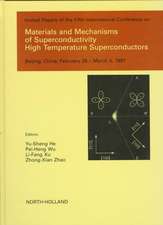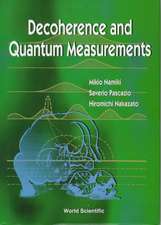Introduction to Quantum Field Theory
Autor Horatiu Nastaseen Limba Engleză Hardback – 16 oct 2019
Preț: 522.36 lei
Preț vechi: 586.93 lei
-11% Nou
Puncte Express: 784
Preț estimativ în valută:
100.00€ • 103.95$ • 82.91£
100.00€ • 103.95$ • 82.91£
Carte disponibilă
Livrare economică 17-31 ianuarie 25
Preluare comenzi: 021 569.72.76
Specificații
ISBN-13: 9781108493994
ISBN-10: 1108493998
Pagini: 730
Ilustrații: 5 b/w illus.
Dimensiuni: 195 x 253 x 38 mm
Greutate: 1.68 kg
Editura: Cambridge University Press
Colecția Cambridge University Press
Locul publicării:Cambridge, United Kingdom
ISBN-10: 1108493998
Pagini: 730
Ilustrații: 5 b/w illus.
Dimensiuni: 195 x 253 x 38 mm
Greutate: 1.68 kg
Editura: Cambridge University Press
Colecția Cambridge University Press
Locul publicării:Cambridge, United Kingdom
Cuprins
1. Review of classical field theory; 2. Quantum mechanics; 3. Canonical quantization of scalar fields; 4. Propagators for free scalar fields; 5. Interaction picture and wick theorem for Λφ4 in operator formalism; 6. Feynman rules for Λφ4 from the operator formalism; 7. The driven (forced) harmonic oscillator; 8. Euclidean formulation and finite temperature field theory; 9. The Feynman path integral for a scalar field; 10. Wick theorem for path integrals and Feynman rules part I; 11. Feynman rules in X-Space and P-Space; 12. Quantization of the Dirac field and Fermionic path integral; 13. Wick theorem, Gaussian integration and Feynman rules for fermions; 14. Spin sums, Dirac field bilinears and C,P,T symmetries for fermions; 15. Dirac quantization of constrained systems; 16. Quantization of gauge fields, their path integral, and the photon propagator; 17. Generating functional for connected Green's Functions and the effective action (1PI Diagrams); 18. Dyson–Schwinger equations and ward identities; 19. Cross sections and the S-Matrix; 20. The S-matrix and Feynman diagrams; 21. The optical theorem and the cutting rules; 22. Unitarity and the largest time equation; 23. QED; 24. Nonrelativistic processes; 25. E+E− → L¯ L unpolarized cross section; 26. E+E− →L¯ L polarized cross section; 27. (Unpolarized) Compton scattering; 28. The Helicity Spinor formalism; 29. Gluon amplitudes, the Parke–Taylor formula and the BCFW construction; 30. Review of path integral and operator formalism and the Feynman diagram expansion; 31. One-loop determinants, vacuum energy and zeta function regularization; 32. One-loop divergences for scalars; 33. Regularization, definitions; 34. One-loop renormalization for scalars and counterterms in dimensional regularization; 35. Renormalization conditions and the renormalization group; 36. One-loop renormalizability in QED; 37. Physical applications of one-loop results 1. Vacuum Polarization; 38. Physical applications of one-loop results 2. Anomalous magnetic moment and lamb shift; 39. Two-loop example and multiloop generalization; 40. The LSZ reduction formula; 41. The Coleman–Weinberg mechanism for one-loop potential; 42. Quantization of gauge theories I; 43. Quantization of gauge theories II; 44. One-loop renormalizability of gauge theories; 45. Asymptotic freedom. BRST symmetry; 46. Lee–Zinn–Justin identities and the structure of divergences (formal renormalization of gauge theories); 47. BRST quantization; 48. QCD; 49. Parton evolution and Altarelli-Parisi equation; 50. The Wilson Loop and the Makeenko–Migdal Loop equation. Order parameters; 'T Hooft Loop; 51. IR divergences in QED; 52. IR safety and renormalization in QCD; General IR-factorized form of amplitudes; 53. Factorization and the Kinoshita–Lee–Nauenberg theorem; 54. Perturbatives anomalies; 55. Anomalies in path integrals – the Fujikawa method; 56. Physical applications of anomalies, 'T Hooft's UV-IR anomaly matching conditions, anomaly cancellation; 57. The Froissart Unitarity Bound and the Heisenberg Model; 58. The operator product expansion, renormalization of composite operators and anomalous dimension matrices; 59. Manipulating loop amplitudes; 60. Analyzing the result for amplitudes; 61. Representations and symmetries for loop amplitudes; 62. The Wilsonian effective action, effective field theory and applications; 63. Kadanoff blocking and the renormalization group; 64. Lattice field theory; 65. The Higgs Mechanism; 66. Renormalization of spontaneously broken gauge theories I; 67. Renormalization of spontaneously broken gauge theories II; 68. Pseudo-Goldstone bosons, nonlinear sigma model and Chiral perturbation theory; 69. The background field method; 70. Finite temperature quantum field theory I; 71. Finite temperature quantum field theory II; 72. Finite temperature quantum field theory III.
Notă biografică
Descriere
A comprehensive, graduate-level textbook introducing quantum field theory, giving equal emphasis to operator and path integral formalisms.

















